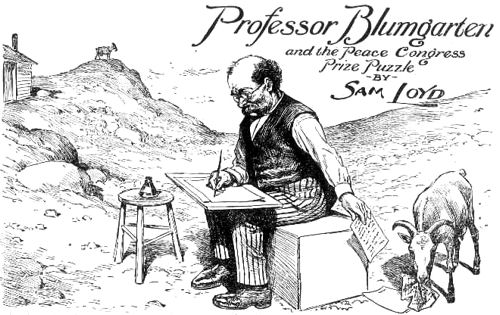



HERE IS THE PUZZLE which Richard H. Proctor, the astronomer termed “the most curious mathematical problem on record.”
“Even if the peace congress should precipitate a conflict between the European powers,” said Professor Blumgarten, “it would be a move in the right direction, for it would set the people to thinking, and that is what we are after.
“In this enlightened age it is the height of folly for two nations to go to war over a matter which could be settled by arbitration. It is a simple calculation to figure up the fighting resources of two quarrelsome nations, to count the number of men, guns and financial resources, and say to the weaker: ‘You are whipped by just 200,000 men, 300 cannon and $500,000,000, which you can pay to the international walking delegates of the Arbitration Committee.
“It is only between nations, men or animals of nearly equal strength where it is difficult to select the superior. Expert arbitrators could determine those fine points. You never see a small dog attack a large one; it is only the fool dog that can't calculate who gets whipped.
“Bicycle races and chess matches could be settled in the same way. The chess forces represent a perfect equality, so the result of a contest could readily be determined by comparing the square root of their mental capacities.
“I found out the true principle of arbitration and universal peace by watching the goats in Harlem. A big goat and a little goat will live together in harmony, because they have nothing to dispute about, but just as soon as two goats of so nearly the same size as to give rise to a question of boss-ship, meet, the fool of the two is killed. Sometimes it ends like the tragedy of the Kilkenny cats:
There once were two cats of Kilkenny.
Each thought there was one cat too many.
So they quarreled and spit, and scratched and hit,
Till, excepting their nails and the tips of their tails,
Instead of two cats there weren’t any.
“I once witnessed such a duel to the death between two goats, which shows the wonderful sagacity of the animals, and at the same time introduces as pretty a mathematical problem as the average puzzlist cares to tackle. A neighbor of mine had a goat which held the undisputed championship of the rocks for several seasons, when some one was so unfortunate as to introduce a new goat which weighed just three pounds heavier. The first weighed 54 pounds, the newcomer 57, and as a goat knows enough not to fight out of his class, and they never fight at catch weights, to all appearances they started in to live harmoniously. But the little fellow planned a piece of deep strategy. He stationed himself at the top of a pretty steep pathway, and from that point of vantage hurled defiance at his rival in a way which the latter could not brook, so he started up the hill on a run and was met by the other, who had the advantage of a downhill run. Sad to tell, both goats were killed by the shock of the collision. Now comes the curious feature of the problem, for George Abercrombie, who wrote a considerable work on the raising of goats, says:
“‘By repeated experiments I have found that the strength of a blow equal to the momentum of 30 pounds falling 20 feet, will just break the skull of a goal, so as to kill it.’ Accepting this remarkable calculation, coming from a distinguished scientist and mathematician as being correct, I shall ask what must have been the respective velocities of the two goats When they meet, so that they just broke one another's skulls?”
In Professor Blumgarten's unique satire upon the workings of the Peace Congress, he gave by way of illustration one of George Abercrombie's curious deductions regarding the strength, or resisting power of a goat’s skull. The distinguished scientist, who lived before the advent of the Society for the Prevention of Cruelty to Animals, says: “By repeated experiments I have found that the strength of a blow equal to the momentum of 30 pounds falling 20 feet, will just break the skull of a goat, so as to kill it.”
The problem was to determine the relative speed of the two animals necessary to kill both. Of course, the problem turns upon the well-known law that a heavy body failing from a state of rest, descends in the first second of time 16 feet and 1 inch, after which it increases in speed in a regular geometrical progression, from which we compute that the 30 pounds falling 20 feet, would give a blow equal to the contact of a 57-pound goat running at the speed of 9.4395 feet per second, meeting a 54-pound goat coming at the rate of 9.9639 feet per second, which would therefore just kill both of the belligerent animals. Of course, it is assumed that the goats strike with equal momentum and ‘drop dead in their tracks,’ otherwise the velocity of either goat might vary from 0 to double the velocity given.
[Page 127]